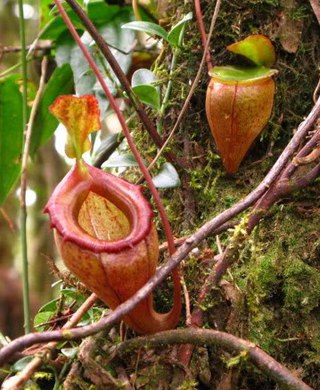
Hemichordata is a phylum which consists of triploblastic, eucoelomate, and bilaterally symmetrical marine deuterostome animals, generally considered the sister group of the echinoderms. They appear in the Lower or Middle Cambrian and include two main classes: Enteropneusta, and Pterobranchia. A third class, Planctosphaeroidea, is known only from the larva of a single species, Planctosphaera pelagica. The class Graptolithina, formerly considered extinct, is now placed within the pterobranchs, represented by a single living genus Rhabdopleura.
Bongo Flava is a nickname for Tanzanian music. The genre developed in the 1990s, mainly as a derivative of American hip hop and traditional Tanzanian styles such as taarab and dansi. Lyrics are usually in Swahili or English.

Sarracenia flava, the yellow pitcherplant, is a carnivorous plant in the family Sarraceniaceae. Like all the Sarraceniaceae, it is native to the New World. Its range extends from southern Alabama, through Florida and Georgia, to the coastal plains of southern Virginia, North Carolina and South Carolina. Populations also exist in the Piedmont, Mendocino County, California and mountains of North Carolina.

The Hillersjö stone, listed in the Rundata catalog as U 29 and located at Hillersjö, which is about four kilometers north of Stenhamra on Färingsö, is a runic Younger Futhark inscription that tells, in Old Norse, the tragic real life family saga of Gerlög and her daughter Inga. It is the longest runic inscription in Uppland and the second longest one in Sweden after the Rök runestone.

The Färentuna runestones are 11th century runestones labelled U 20, U 21, and U 22 in the Rundata catalog that are located in Färentuna, Uppland, Sweden. Runestones U 20 and U 21 were registered separately although they come from the same original runestone and consequently are called U 20/21. The runestone U 20/U 21 is probably most interesting as it, together with the Hillersjö stone and the Snottsta and Vreta stones, tells the story of the family of Gerlög and Inga. All of the Färentuna runestones are inscribed in the younger futhark.
Pseudalbizzia pistaciifolia is a species of plant in the family Fabaceae. It is found in Colombia, Ecuador, and Venezuela.

Nepenthes flava is a tropical pitcher plant endemic to northern Sumatra, where it grows in montane forest at 1800–2200 m above sea level.

Flava Works, Inc. is an independent company that produces gay media featuring black and Latino men. Its headquarters are in Miami, Florida, with a satellite office in Chicago, Illinois.

The eastern yellow wagtail is a small passerine in the wagtail family Motacillidae, which also includes the pipits and longclaws. It was often classified as a subspecies of the Western yellow wagtail. It breeds in the eastern Palearctic and Alaska and migrates to South Asia and Australia.

Inga and Anush Ashoti Arshakyan or the Arshakyan Sisters are an Armenian folk singing duo. The sisters represented Armenia in the Eurovision Song Contest 2009, eventually finishing in 10th place in the final.

Sailin' Da South is the second studio album by American rapper E.S.G. from Houston, Texas. It was released on September 12, 1995 via Priority Records, making it his first record on a major label. The album peaked at #29 on the Top R&B/Hip-Hop Albums and #19 on the Heatseekers Albums in the US Billboard charts.

Flava is a New Zealand classic hip hop and R&B music radio network. The network is owned by NZME Radio, and is operated and produced from the company's Auckland offices and studios on Graham Street. It competes directly with MediaWorks New Zealand's Auckland long-running modern urban music station Mai FM.

Littoraria flava is a species of sea snail, a marine gastropod mollusk in the family Littorinidae, the winkles or periwinkles.
Zenji flava is a common nickname for Zanzibari hip hop, a genre that began to develop in the 1990s. The name is made of zenji, which is slang for "Zanzibar", and flava, which is a corruption of "flavour", thus meaning "of Zanzibari taste". As with bongo flava, i.e., Tanzanian mainland's hip hop, zenji flava is usually sung in swahili; the main difference between the two subgenres is that Zanzibari hip hop also reflects some influence of taarab, and thus indirectly of Arab music and Indian music. Notable zenji flava artists include Ali Haji. As Zenji flavour goes on it find itself as a sub part of Bongo flava as it has influence from the young generation of artists who want to cop with Bongo flava. like Offside trick, 2 berry now is separated to form two solo artists, Wazenji kijiwe and Shaka zulu, others are East connection which was made up with almost seven groups of artist including Offside trick Brooklyn, Four nature, Jumbo camp, Queen love, and K jam. It was in this time that Zenji flava was modernized with rapid growth in the number of artists.

Limnocharis flava is a species of aquatic flowering plant which is native to Mexico, Central America, South America, Cuba, Haiti and the Dominican Republic but widely naturalized in southern and southeastern Asia: India, Sri Lanka, Cambodia, Burma, Thailand, Vietnam, Indonesia, Malaysia, Brunei and southern China.

Inga is a genus of moths of the family Oecophoridae.
Dmytro Zajciw was a Ukrainian and Brazilian entomologist, notable for his many beetle discoveries and for his collection. He was born in Velyka Mykhailivka, Ukraine and died in Rio de Janeiro, Brazil. He was the author of Two new genera and species of neotropical Longhorn beetles , 1957, Contribution to the study of Longhorn beetles of Rio de Janeiro , 1958, and was the first to describe the genera Adesmoides and Pseudogrammopsis, as well as the species Beraba angusticollis and Mionochroma subaurosum, among many others.

The Valley Where Time Stood Still is a science fantasy novel by American writer Lin Carter, the second in his Edgar Rice Burroughs- and Leigh Brackett-inspired series The Mysteries of Mars. It was first published in hardcover by Doubleday in December 1974 and in paperback by Popular Library in February 1976. It was reissued by Wildside Press in April 2008.













